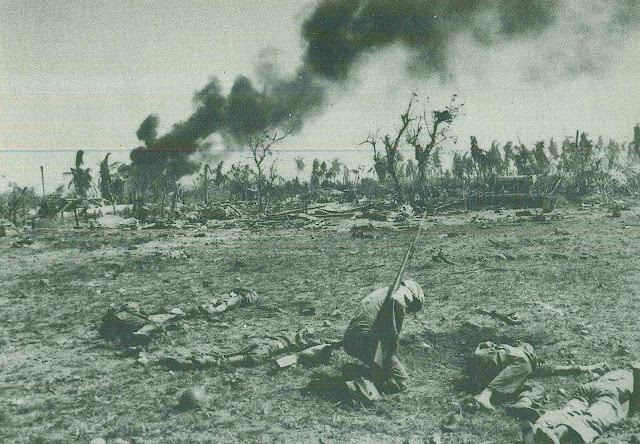During the Battle of Kwajalein Atoll in the Pacific War, black smoke billowed from the Japanese position on Namur Island as a result of the American invasion. Many dead Japanese soldiers were scattered around the Japanese position. American soldiers conducted autopsies on the corpses. Namur Island in Kwajalein Atoll was recaptured by American forces during the Battle of Kwajalein, which began on February 9, 1944. The Battle of Kwajalein was a battle that took place from January 30 to February 3, 1944, at the end of World War II, when American forces invaded Kwajalein Atoll, which was defended by Japanese forces.
The U.S. Army's 24th Marine Regiment began landing on Namur Island around 9:00 a.m. on February 2, 1944. A small number of Japanese soldiers attempted to resist on Namulu Island by hiding behind palm tree logs. The U.S. forces overwhelmed and crushed them with flamethrowers and explosives, and by the next day, February 3, they were annihilated. 11:18 a.m. on February 3, the occupation of Namul Island was declared. On Namul Island, a small number of Japanese soldiers hid behind palm tree logs and attempted to resist the American troops, but they were successively crushed by flamethrowers and explosives and annihilated by February 3. The Japanese Imperial Headquarters announced the Gyokusai on February 25 with the total destruction of Kwajalein Island, Ruot Island, and Namur Island.
On January 30, 1944, after massive air raids and naval bombardment, American forces totaling about 85,000 men approached the Marshall Islands; on February 1, the U.S. 7th Infantry (Army) Division landed on Kwajalein Island. The 4th Marine Division landed on the twin islands of Loi and Namur, about 72 km to the north. During the Japanese occupation, Loi Island to the west and Namul Island to the east were connected by a narrow land and causeway. Artillery bombardment had thoroughly destroyed the interior of Namulu Island, leaving it almost deserted and the palm forests burned to the ground; they captured Loi Island on February 1, and Namulu Island fell by noon on February 3. In the Battle of Kwajalein, the U.S. 7th Infantry Division declared Kwajalein Island safe on February 4. The Japanese were outnumbered by the Americans from the start and chose to fight to the last and be annihilated in a crushing defeat. Japanese casualties on the islands of Roi and Namur were over 3,500 dead and about 200 prisoners of war. The U.S. Marines suffered less than 200 dead and about 500 wounded. On Kwajalein Island, nearly 5,000 Japanese soldiers were killed in action and only a handful were captured.




No comments:
Post a Comment